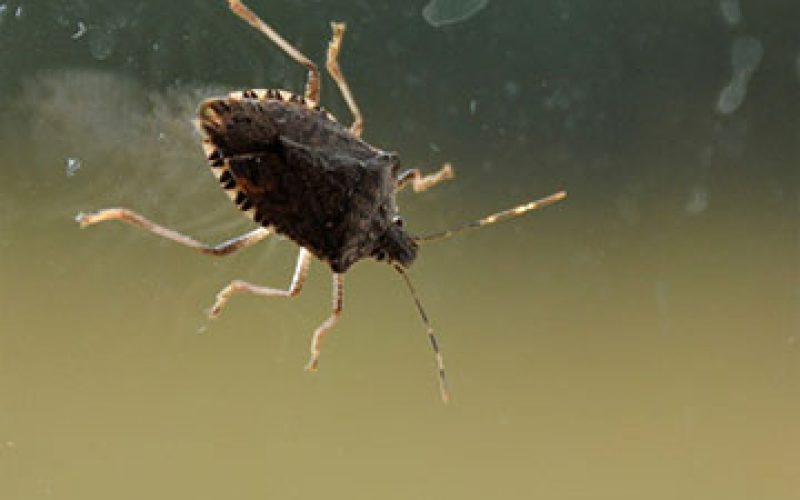Stink bugs a nuisance every autumn
AMANDA BANCROFT
Making Ripples
Do you smell a skunk inside your house, or suddenly catch a whiff of burning tires or, perhaps pleasantly, detect cilantro or coriander and assume someone is cooking with it? You might have stink bugs. They appear en masse for a couple of weeks around the autumn equinox. Their name comes from the smell they produce in a gland on their abdomens.
I’m one of the lucky ones who actually enjoys the odor of skunk from a distance, and stink bugs smell like cilantro to me. One bug smells like cilantro, but one hundred inside a container smell like nothing you want to know. Last year we didn’t know what they were, and charmed by their personalities, we released any we caught. This year, better educated in their identity, we take no prisoners! Each day, we trap and drown about half a dozen up to two dozen inside the house, and 50 to 100 on the exterior.

The brown marmorated stink bug (Halyomorpha halys) — not to be confused with our native stink bugs, soldier bugs and lookalikes — is a hitchhiker. It was introduced to Pennsylvania from Asia, then into other states by hitching rides on transport vehicles.
(Courtesy Photos/Amanda Bancroft)
They take the phrase “mi casa es su casa” to the extreme when they begin to search for overwintering sites, covering the home in clusters of hundreds. They crawl into cupboards, pillowcases and bookshelves. Once, one even hid inside my wall-mounted toothbrush holder and was perched upon the bristles when I went to brush my teeth!
The brown marmorated stink bug (Halyomorpha halys) — not to be confused with our native stink bugs, soldier bugs and lookalikes — is a hitchhiker. It was introduced to Pennsylvania from Asia, then into other states by hitching rides on transport vehicles. Brown marmorated stink bugs (BMSB) were verified in Washington County in 2013, according to the University of Arkansas Extension Service. Adult BMSB are mottled brown, around a half-inch long and shaped like shields, ready to do battle. To distinguish them from similar native bugs, look for their false white flag of surrender: their antennae are banded with white, while natives lack this feature (among other differences).
It’s important to seal any cracks or openings where they can enter the home and overwinter, but we clearly have not found them all. We tried spraying peppermint, but that did absolutely nothing to deter them. What seems to work best is drowning them in containers of water with a squirt of liquid dish soap added. It takes only minutes for them to drown, and the container traps the smell. We walk around the house every afternoon, one hand holding the container, the other popping the stink bugs inside — flick, plop, flick, plop — until we’ve gotten all that we can reach.
Stink bugs can’t bite, sting or cause structural damage to homes and properties. For homeowners, they’re just an annoyance, but they significantly damage crops and contribute to ecological imbalance. Have hope, because native predators have figured out that they have a new snack. Birds, spiders — especially jumping spiders — bats, assassin bugs, parasitic flies and — did you see this coming? — other stink bugs all prey on the BMSB. Predatory stink bug species feed on the plant-eating stink bugs, but also caterpillars and other insects, a trait that crop farmers particularly appreciate.

The brown marmorated stink bug (Halyomorpha halys) — not to be confused with our native stink bugs, soldier bugs and lookalikes — is a hitchhiker. It was introduced to Pennsylvania from Asia, then into other states by hitching rides on transport vehicles.
(Courtesy Photos/Amanda Bancroft)
Dr. Rob Morrison wrote for Entomology Today in 2016 that “the most common and frequent predation was by katydids,” and this native predator can consume entire egg masses as observed in the field by researchers. “In addition to katydids, the most frequent and voracious predators of BMSB stink bug eggs included crickets, ground beetles, jumping spiders and earwigs.” I observed large jumping spiders stalking and eating adult stink bugs. Encouraging these native predators could help control populations and bring the BMSB back into balance within the web of life, of which we are all a part.
Amanda Bancroft is a writer, artist, and naturalist living in an off-grid tiny house on Kessler Mountain. She and her husband Ryan blog about their adventures and offer tips to those wanting to make a difference at www.RipplesBlog.org.










